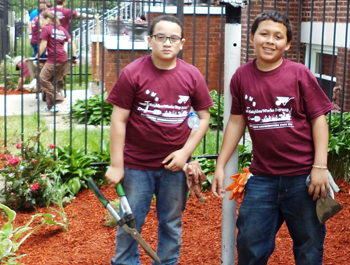Image

Kristin Faust, President, Neighborhood Housing Services of Chicago
Challenge: In Chicago's West Humboldt Park, the 500 block of North Central Park was considered one of the severest areas of blight in the neighborhood. This block had historically high vacancies, lack of private investment and a high crime rate, making it difficult to attract potential homeowners.
During the housing crisis, the 500 block of North Central Park in West Humboldt Park experienced a rapid increase in foreclosure, abandonment and marginalization. "There were eight vacant properties on this block, and only a faint pulse," says John Groene, Neighborhood Director of the West Humboldt Park Neighborhood Housing Services (NHS) office. In response, Groene and his team championed the "superblock" approach to development, with the goal of reviving the block by working collaboratively, and pouring multiple resources into a concentrated hub of the community.
When this block became a target area for the City of Chicago's Micro Market Recovery Program (MMRP), NHS created a strategy for visible improvements on the block that would reverberate throughout the neighborhood. MMRP provides structure that NHS and cross-sector partner organizations use to focus housing and community development resources (e.g., foreclosure court receivership or forgivable loan purchase assistance grants) on a geographically defined set of blocks. One of the main MMRP goals is aimed at reoccupying vacant residential buildings and helping existing residents remain in their homes.
NHS focused on the 500 block of Central Park because it is the southern gateway into the community. "Perception is reality. When residents entered West Humboldt Park they were greeted with a morose image," says Groene.
To support its work, NHS used its strengths of established resident relationships and a neighborhood office. The organization held hundreds of meetings at local NHS office, with a focus on collaboratively reclaiming vacant buildings on the block.
NHS partnered with Mercy Housing to acquire several of the buildings, featuring one to four residential units. Community Investment Corporation and Bickerdike Redevelopment Corporation worked to bring in multi-family building owners. NHS also partnered with The Neighborhood Foundation, which installed decorative board-ups over windows and doors of vacant buildings to discourage vandalism and beautify the neighborhood.
 NHS further acquired, rehabbed and repurposed four properties on the superblock that were in danger of being demolished. The buildings now serve as affordable rental housing for veterans with children (managed by nonprofit partner Childserv), and as commercial property. A single remaining vacant building on the block is currently under renovation and under contract with a pre-approved NHS buyer.
NHS further acquired, rehabbed and repurposed four properties on the superblock that were in danger of being demolished. The buildings now serve as affordable rental housing for veterans with children (managed by nonprofit partner Childserv), and as commercial property. A single remaining vacant building on the block is currently under renovation and under contract with a pre-approved NHS buyer."Raise the resident commitment and there will be a ripple effect of investment back into the community," says Groene. Indeed, that's just what happened in West Humboldt Park.
A community resident created the Ujima Garden at the northeast corner of the North Central Park block. This led to the creation of the West Humboldt Park farmer's market, located in the parking lot of the NHS office. "Ujima Garden is ADA-accessible and utilized by neighbors, local schools, churches and community groups," says the founder, Nita Hailey-Gamble.
West Humboldt Park's positive transformation extends to the Chicago Avenue main commercial corridor. Along with infrastructure improvements, new businesses have opened, including Brother-In-Law Ribs and Turkey Chop Gourmet Grill. New educational institutions include Rowe Clark Math and Science Academy and the Richard M. Daley Library. The five-acre Salvation Army Freedom Center campus and Children's Place Association opened their new three-story, 19,000-square-foot facility at the corner of Chicago Avenue and Drake.
"Our next superblocks will be the 900 block of North Drake and then the 700 block of North Central Park," says Groene. "NHS now owns two properties on Drake, and soon will own three more. We'll go through the same process as with the 500 block of North Central Park, but hopefully reduce the time it takes to turn around a block."
Lessons learned from the superblock project in West Humboldt Park include:
- Promotion of neighborhood change has to be organic.
- Developing a pipeline of pre-approved, first-time homebuyers is essential.
- Developing marketing materials showing the stages of the building rehabbing process helps resident visualize.
- Working on several buildings at once creates economies of scale.
The West Humboldt Park superblock model is a great example of reclaiming vacant properties from the inside out. If residents take the lead, identify outcomes and create an environment for action, resulting leadership will trump any unwanted and external redevelopment plans created. NHS attributes its success to being present in the community and listening to resident needs. Planning for the physical appearance of a neighborhood is important, but equally important is tapping into the heart and soul of a community that raises up voices, values and vision.

